Reflective Essay on Simulated Group Work: Psycho-dynamic Theory
VerifiedAdded on 2023/05/31
|7
|1625
|440
Essay
AI Summary
This reflective essay explores the juvenile justice system through the lens of the remedial model and psycho-dynamic theory, focusing on juvenile delinquency and its causes. It presents narratives of individuals who have interacted with the juvenile system due to offenses like drug use, alcoholism, car theft, and shoplifting. The essay highlights the role of family relationships, peer influence, and the impact of incarceration and rehabilitation programs on juvenile offenders. It also touches upon the various services provided within the juvenile system, including medical and therapeutic interventions, aimed at transforming the habits and behaviors of young offenders. Desklib offers more solved assignments and study resources for students.
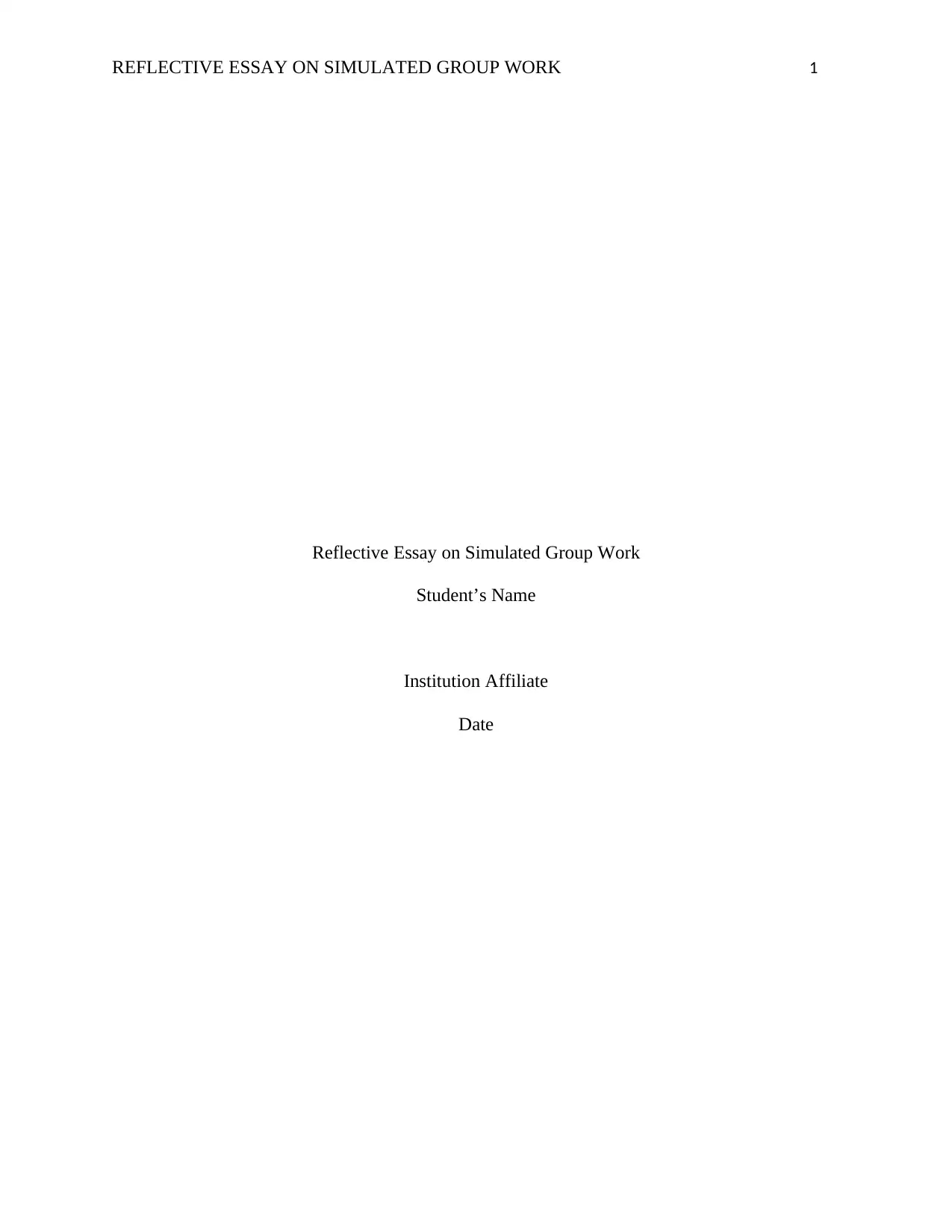
REFLECTIVE ESSAY ON SIMULATED GROUP WORK 1
Reflective Essay on Simulated Group Work
Student’s Name
Institution Affiliate
Date
Reflective Essay on Simulated Group Work
Student’s Name
Institution Affiliate
Date
Paraphrase This Document
Need a fresh take? Get an instant paraphrase of this document with our AI Paraphraser
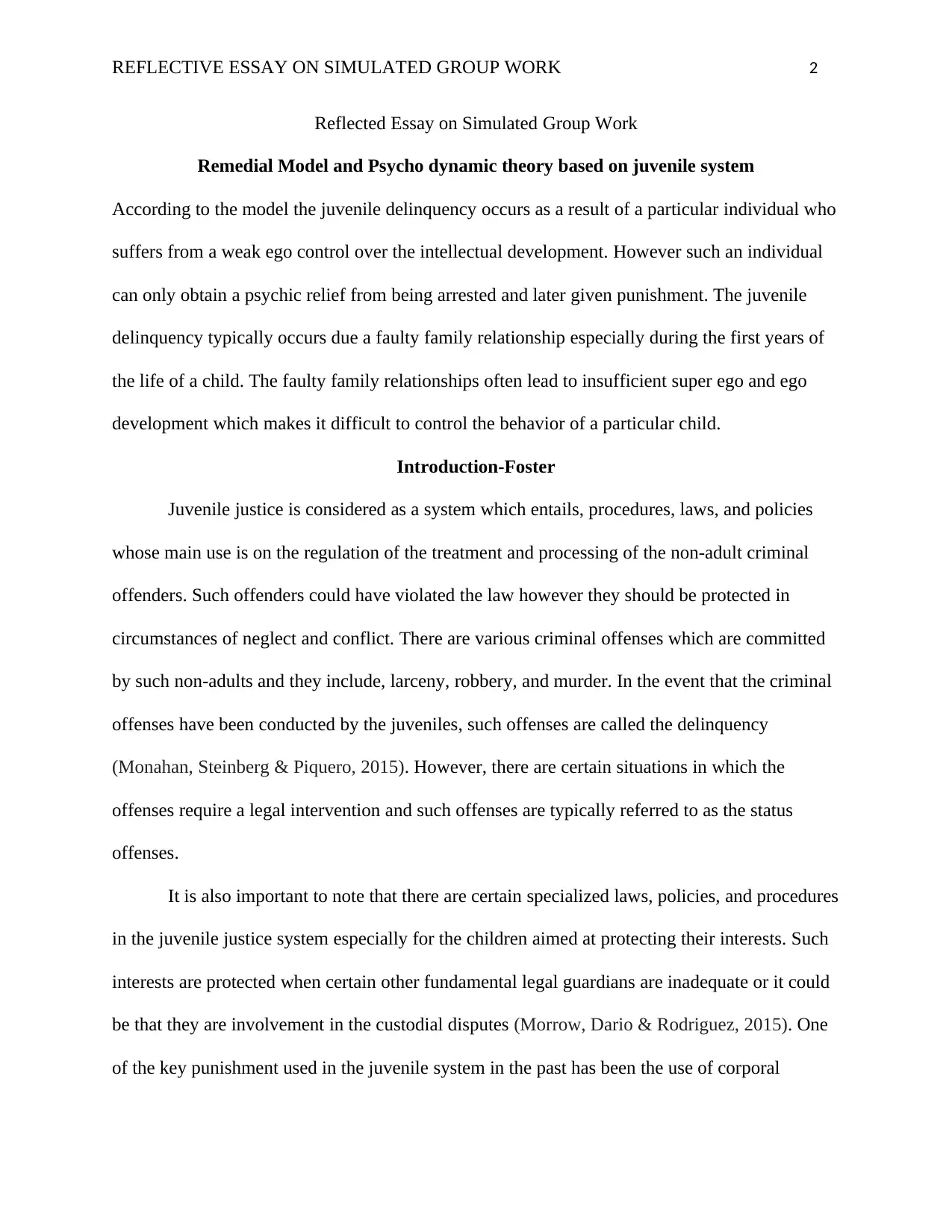
REFLECTIVE ESSAY ON SIMULATED GROUP WORK 2
Reflected Essay on Simulated Group Work
Remedial Model and Psycho dynamic theory based on juvenile system
According to the model the juvenile delinquency occurs as a result of a particular individual who
suffers from a weak ego control over the intellectual development. However such an individual
can only obtain a psychic relief from being arrested and later given punishment. The juvenile
delinquency typically occurs due a faulty family relationship especially during the first years of
the life of a child. The faulty family relationships often lead to insufficient super ego and ego
development which makes it difficult to control the behavior of a particular child.
Introduction-Foster
Juvenile justice is considered as a system which entails, procedures, laws, and policies
whose main use is on the regulation of the treatment and processing of the non-adult criminal
offenders. Such offenders could have violated the law however they should be protected in
circumstances of neglect and conflict. There are various criminal offenses which are committed
by such non-adults and they include, larceny, robbery, and murder. In the event that the criminal
offenses have been conducted by the juveniles, such offenses are called the delinquency
(Monahan, Steinberg & Piquero, 2015). However, there are certain situations in which the
offenses require a legal intervention and such offenses are typically referred to as the status
offenses.
It is also important to note that there are certain specialized laws, policies, and procedures
in the juvenile justice system especially for the children aimed at protecting their interests. Such
interests are protected when certain other fundamental legal guardians are inadequate or it could
be that they are involvement in the custodial disputes (Morrow, Dario & Rodriguez, 2015). One
of the key punishment used in the juvenile system in the past has been the use of corporal
Reflected Essay on Simulated Group Work
Remedial Model and Psycho dynamic theory based on juvenile system
According to the model the juvenile delinquency occurs as a result of a particular individual who
suffers from a weak ego control over the intellectual development. However such an individual
can only obtain a psychic relief from being arrested and later given punishment. The juvenile
delinquency typically occurs due a faulty family relationship especially during the first years of
the life of a child. The faulty family relationships often lead to insufficient super ego and ego
development which makes it difficult to control the behavior of a particular child.
Introduction-Foster
Juvenile justice is considered as a system which entails, procedures, laws, and policies
whose main use is on the regulation of the treatment and processing of the non-adult criminal
offenders. Such offenders could have violated the law however they should be protected in
circumstances of neglect and conflict. There are various criminal offenses which are committed
by such non-adults and they include, larceny, robbery, and murder. In the event that the criminal
offenses have been conducted by the juveniles, such offenses are called the delinquency
(Monahan, Steinberg & Piquero, 2015). However, there are certain situations in which the
offenses require a legal intervention and such offenses are typically referred to as the status
offenses.
It is also important to note that there are certain specialized laws, policies, and procedures
in the juvenile justice system especially for the children aimed at protecting their interests. Such
interests are protected when certain other fundamental legal guardians are inadequate or it could
be that they are involvement in the custodial disputes (Morrow, Dario & Rodriguez, 2015). One
of the key punishment used in the juvenile system in the past has been the use of corporal
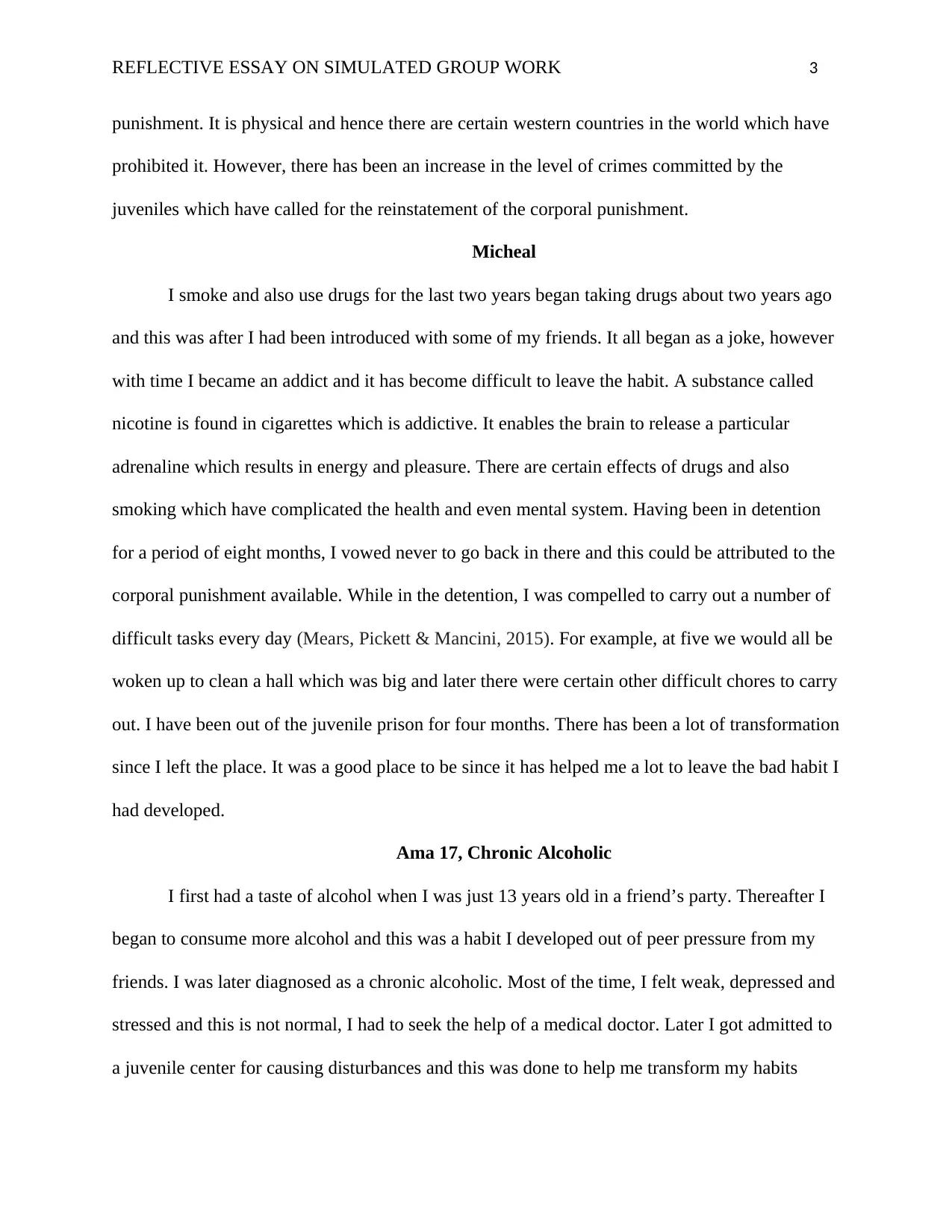
REFLECTIVE ESSAY ON SIMULATED GROUP WORK 3
punishment. It is physical and hence there are certain western countries in the world which have
prohibited it. However, there has been an increase in the level of crimes committed by the
juveniles which have called for the reinstatement of the corporal punishment.
Micheal
I smoke and also use drugs for the last two years began taking drugs about two years ago
and this was after I had been introduced with some of my friends. It all began as a joke, however
with time I became an addict and it has become difficult to leave the habit. A substance called
nicotine is found in cigarettes which is addictive. It enables the brain to release a particular
adrenaline which results in energy and pleasure. There are certain effects of drugs and also
smoking which have complicated the health and even mental system. Having been in detention
for a period of eight months, I vowed never to go back in there and this could be attributed to the
corporal punishment available. While in the detention, I was compelled to carry out a number of
difficult tasks every day (Mears, Pickett & Mancini, 2015). For example, at five we would all be
woken up to clean a hall which was big and later there were certain other difficult chores to carry
out. I have been out of the juvenile prison for four months. There has been a lot of transformation
since I left the place. It was a good place to be since it has helped me a lot to leave the bad habit I
had developed.
Ama 17, Chronic Alcoholic
I first had a taste of alcohol when I was just 13 years old in a friend’s party. Thereafter I
began to consume more alcohol and this was a habit I developed out of peer pressure from my
friends. I was later diagnosed as a chronic alcoholic. Most of the time, I felt weak, depressed and
stressed and this is not normal, I had to seek the help of a medical doctor. Later I got admitted to
a juvenile center for causing disturbances and this was done to help me transform my habits
punishment. It is physical and hence there are certain western countries in the world which have
prohibited it. However, there has been an increase in the level of crimes committed by the
juveniles which have called for the reinstatement of the corporal punishment.
Micheal
I smoke and also use drugs for the last two years began taking drugs about two years ago
and this was after I had been introduced with some of my friends. It all began as a joke, however
with time I became an addict and it has become difficult to leave the habit. A substance called
nicotine is found in cigarettes which is addictive. It enables the brain to release a particular
adrenaline which results in energy and pleasure. There are certain effects of drugs and also
smoking which have complicated the health and even mental system. Having been in detention
for a period of eight months, I vowed never to go back in there and this could be attributed to the
corporal punishment available. While in the detention, I was compelled to carry out a number of
difficult tasks every day (Mears, Pickett & Mancini, 2015). For example, at five we would all be
woken up to clean a hall which was big and later there were certain other difficult chores to carry
out. I have been out of the juvenile prison for four months. There has been a lot of transformation
since I left the place. It was a good place to be since it has helped me a lot to leave the bad habit I
had developed.
Ama 17, Chronic Alcoholic
I first had a taste of alcohol when I was just 13 years old in a friend’s party. Thereafter I
began to consume more alcohol and this was a habit I developed out of peer pressure from my
friends. I was later diagnosed as a chronic alcoholic. Most of the time, I felt weak, depressed and
stressed and this is not normal, I had to seek the help of a medical doctor. Later I got admitted to
a juvenile center for causing disturbances and this was done to help me transform my habits
⊘ This is a preview!⊘
Do you want full access?
Subscribe today to unlock all pages.

Trusted by 1+ million students worldwide
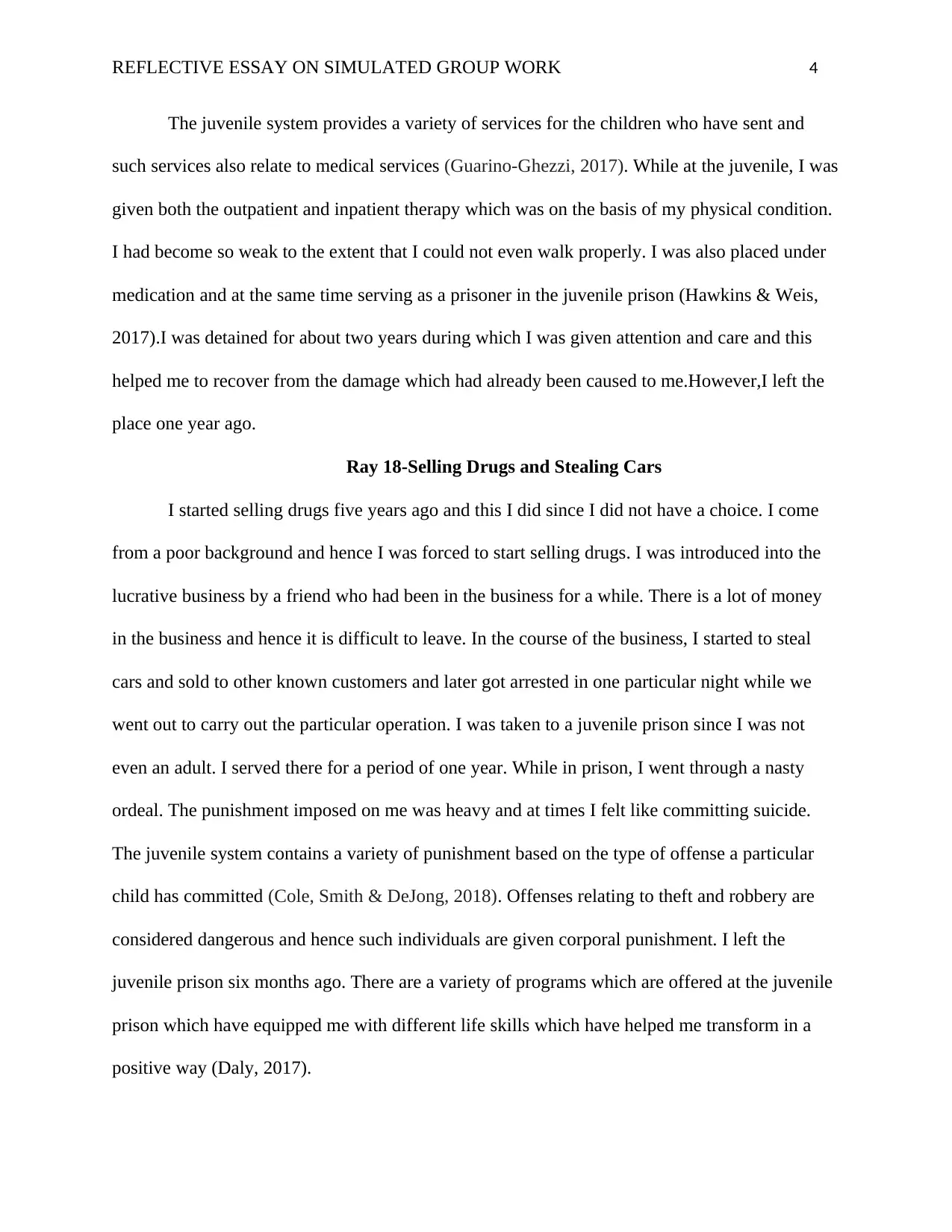
REFLECTIVE ESSAY ON SIMULATED GROUP WORK 4
The juvenile system provides a variety of services for the children who have sent and
such services also relate to medical services (Guarino-Ghezzi, 2017). While at the juvenile, I was
given both the outpatient and inpatient therapy which was on the basis of my physical condition.
I had become so weak to the extent that I could not even walk properly. I was also placed under
medication and at the same time serving as a prisoner in the juvenile prison (Hawkins & Weis,
2017).I was detained for about two years during which I was given attention and care and this
helped me to recover from the damage which had already been caused to me.However,I left the
place one year ago.
Ray 18-Selling Drugs and Stealing Cars
I started selling drugs five years ago and this I did since I did not have a choice. I come
from a poor background and hence I was forced to start selling drugs. I was introduced into the
lucrative business by a friend who had been in the business for a while. There is a lot of money
in the business and hence it is difficult to leave. In the course of the business, I started to steal
cars and sold to other known customers and later got arrested in one particular night while we
went out to carry out the particular operation. I was taken to a juvenile prison since I was not
even an adult. I served there for a period of one year. While in prison, I went through a nasty
ordeal. The punishment imposed on me was heavy and at times I felt like committing suicide.
The juvenile system contains a variety of punishment based on the type of offense a particular
child has committed (Cole, Smith & DeJong, 2018). Offenses relating to theft and robbery are
considered dangerous and hence such individuals are given corporal punishment. I left the
juvenile prison six months ago. There are a variety of programs which are offered at the juvenile
prison which have equipped me with different life skills which have helped me transform in a
positive way (Daly, 2017).
The juvenile system provides a variety of services for the children who have sent and
such services also relate to medical services (Guarino-Ghezzi, 2017). While at the juvenile, I was
given both the outpatient and inpatient therapy which was on the basis of my physical condition.
I had become so weak to the extent that I could not even walk properly. I was also placed under
medication and at the same time serving as a prisoner in the juvenile prison (Hawkins & Weis,
2017).I was detained for about two years during which I was given attention and care and this
helped me to recover from the damage which had already been caused to me.However,I left the
place one year ago.
Ray 18-Selling Drugs and Stealing Cars
I started selling drugs five years ago and this I did since I did not have a choice. I come
from a poor background and hence I was forced to start selling drugs. I was introduced into the
lucrative business by a friend who had been in the business for a while. There is a lot of money
in the business and hence it is difficult to leave. In the course of the business, I started to steal
cars and sold to other known customers and later got arrested in one particular night while we
went out to carry out the particular operation. I was taken to a juvenile prison since I was not
even an adult. I served there for a period of one year. While in prison, I went through a nasty
ordeal. The punishment imposed on me was heavy and at times I felt like committing suicide.
The juvenile system contains a variety of punishment based on the type of offense a particular
child has committed (Cole, Smith & DeJong, 2018). Offenses relating to theft and robbery are
considered dangerous and hence such individuals are given corporal punishment. I left the
juvenile prison six months ago. There are a variety of programs which are offered at the juvenile
prison which have equipped me with different life skills which have helped me transform in a
positive way (Daly, 2017).
Paraphrase This Document
Need a fresh take? Get an instant paraphrase of this document with our AI Paraphraser
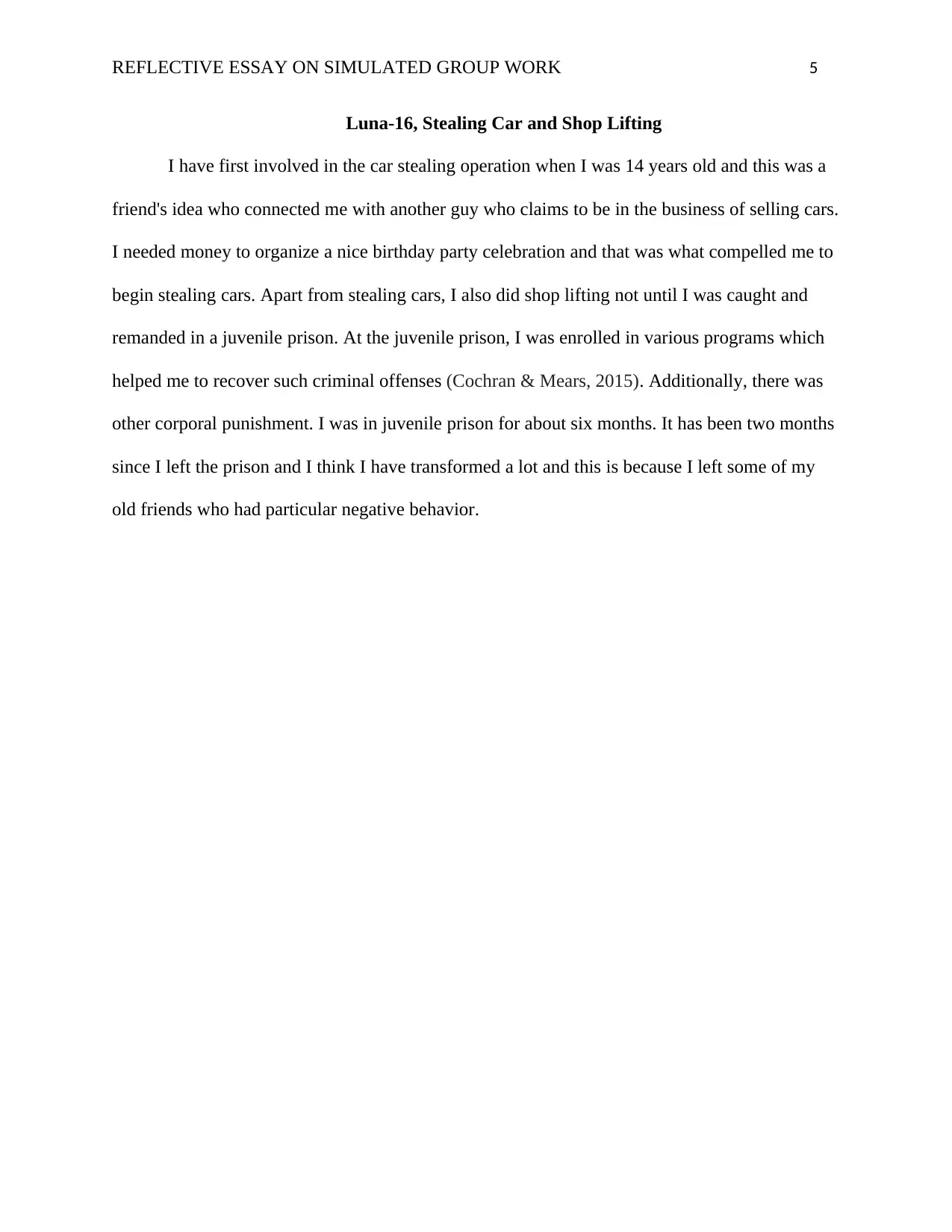
REFLECTIVE ESSAY ON SIMULATED GROUP WORK 5
Luna-16, Stealing Car and Shop Lifting
I have first involved in the car stealing operation when I was 14 years old and this was a
friend's idea who connected me with another guy who claims to be in the business of selling cars.
I needed money to organize a nice birthday party celebration and that was what compelled me to
begin stealing cars. Apart from stealing cars, I also did shop lifting not until I was caught and
remanded in a juvenile prison. At the juvenile prison, I was enrolled in various programs which
helped me to recover such criminal offenses (Cochran & Mears, 2015). Additionally, there was
other corporal punishment. I was in juvenile prison for about six months. It has been two months
since I left the prison and I think I have transformed a lot and this is because I left some of my
old friends who had particular negative behavior.
Luna-16, Stealing Car and Shop Lifting
I have first involved in the car stealing operation when I was 14 years old and this was a
friend's idea who connected me with another guy who claims to be in the business of selling cars.
I needed money to organize a nice birthday party celebration and that was what compelled me to
begin stealing cars. Apart from stealing cars, I also did shop lifting not until I was caught and
remanded in a juvenile prison. At the juvenile prison, I was enrolled in various programs which
helped me to recover such criminal offenses (Cochran & Mears, 2015). Additionally, there was
other corporal punishment. I was in juvenile prison for about six months. It has been two months
since I left the prison and I think I have transformed a lot and this is because I left some of my
old friends who had particular negative behavior.
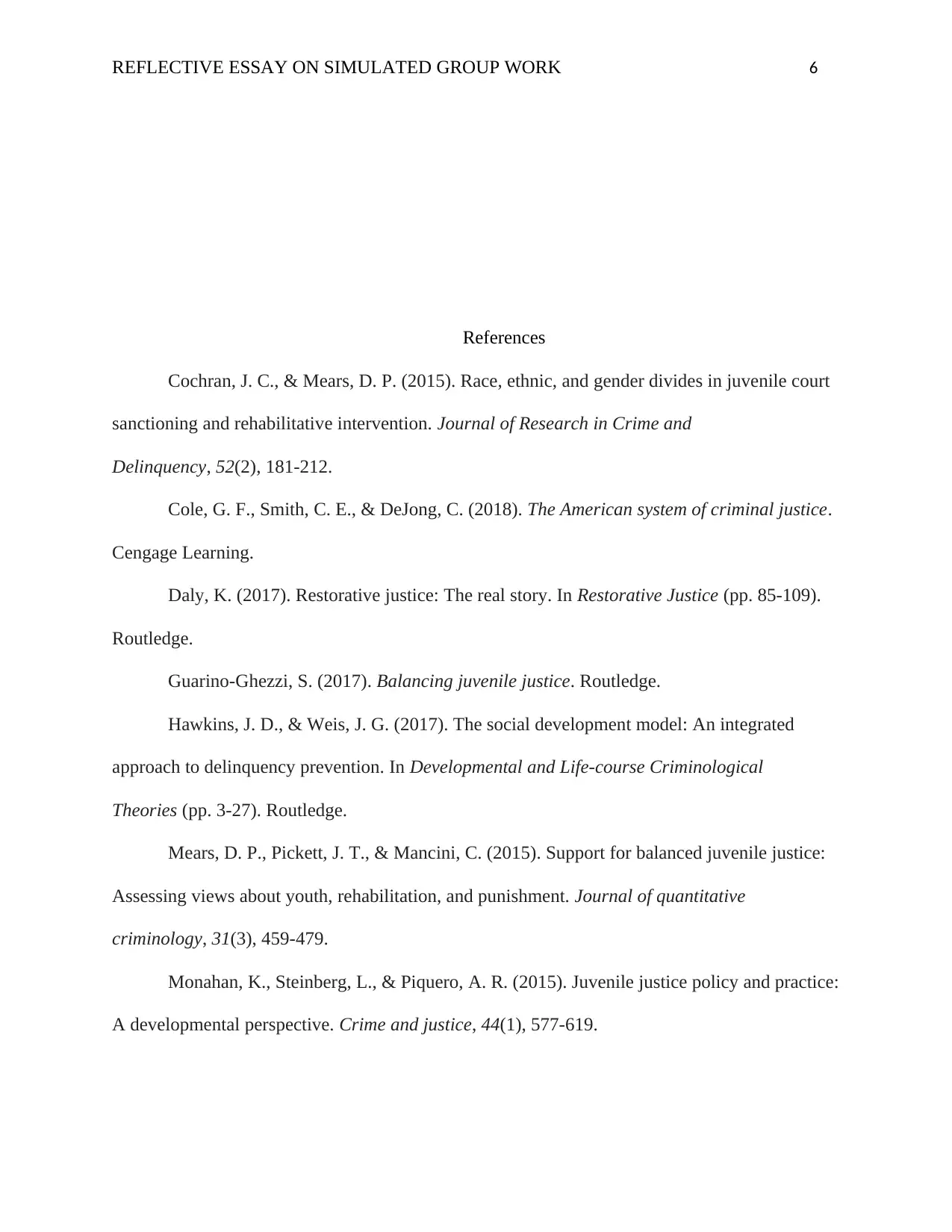
REFLECTIVE ESSAY ON SIMULATED GROUP WORK 6
References
Cochran, J. C., & Mears, D. P. (2015). Race, ethnic, and gender divides in juvenile court
sanctioning and rehabilitative intervention. Journal of Research in Crime and
Delinquency, 52(2), 181-212.
Cole, G. F., Smith, C. E., & DeJong, C. (2018). The American system of criminal justice.
Cengage Learning.
Daly, K. (2017). Restorative justice: The real story. In Restorative Justice (pp. 85-109).
Routledge.
Guarino-Ghezzi, S. (2017). Balancing juvenile justice. Routledge.
Hawkins, J. D., & Weis, J. G. (2017). The social development model: An integrated
approach to delinquency prevention. In Developmental and Life-course Criminological
Theories (pp. 3-27). Routledge.
Mears, D. P., Pickett, J. T., & Mancini, C. (2015). Support for balanced juvenile justice:
Assessing views about youth, rehabilitation, and punishment. Journal of quantitative
criminology, 31(3), 459-479.
Monahan, K., Steinberg, L., & Piquero, A. R. (2015). Juvenile justice policy and practice:
A developmental perspective. Crime and justice, 44(1), 577-619.
References
Cochran, J. C., & Mears, D. P. (2015). Race, ethnic, and gender divides in juvenile court
sanctioning and rehabilitative intervention. Journal of Research in Crime and
Delinquency, 52(2), 181-212.
Cole, G. F., Smith, C. E., & DeJong, C. (2018). The American system of criminal justice.
Cengage Learning.
Daly, K. (2017). Restorative justice: The real story. In Restorative Justice (pp. 85-109).
Routledge.
Guarino-Ghezzi, S. (2017). Balancing juvenile justice. Routledge.
Hawkins, J. D., & Weis, J. G. (2017). The social development model: An integrated
approach to delinquency prevention. In Developmental and Life-course Criminological
Theories (pp. 3-27). Routledge.
Mears, D. P., Pickett, J. T., & Mancini, C. (2015). Support for balanced juvenile justice:
Assessing views about youth, rehabilitation, and punishment. Journal of quantitative
criminology, 31(3), 459-479.
Monahan, K., Steinberg, L., & Piquero, A. R. (2015). Juvenile justice policy and practice:
A developmental perspective. Crime and justice, 44(1), 577-619.
⊘ This is a preview!⊘
Do you want full access?
Subscribe today to unlock all pages.

Trusted by 1+ million students worldwide
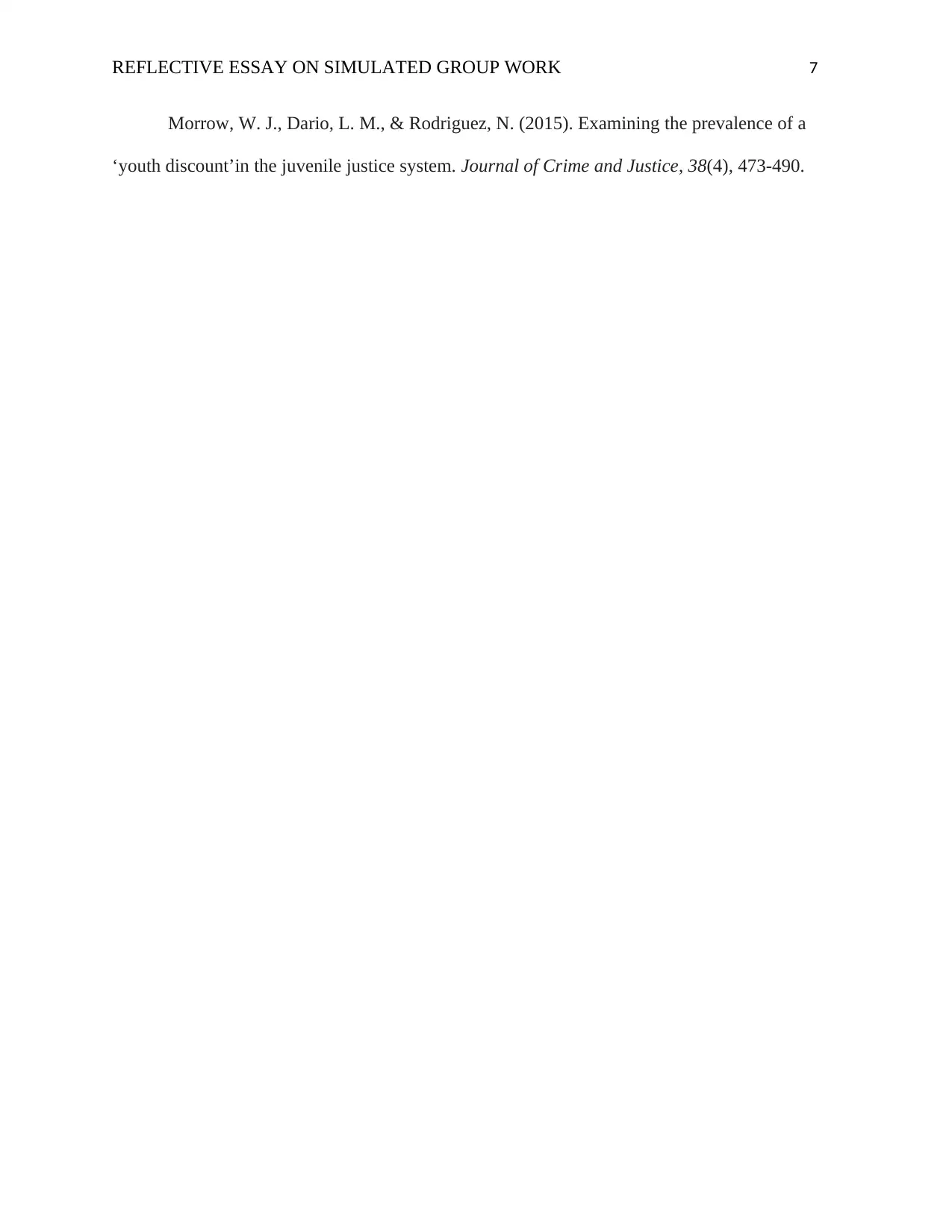
REFLECTIVE ESSAY ON SIMULATED GROUP WORK 7
Morrow, W. J., Dario, L. M., & Rodriguez, N. (2015). Examining the prevalence of a
‘youth discount’in the juvenile justice system. Journal of Crime and Justice, 38(4), 473-490.
Morrow, W. J., Dario, L. M., & Rodriguez, N. (2015). Examining the prevalence of a
‘youth discount’in the juvenile justice system. Journal of Crime and Justice, 38(4), 473-490.
1 out of 7
Related Documents
Your All-in-One AI-Powered Toolkit for Academic Success.
+13062052269
info@desklib.com
Available 24*7 on WhatsApp / Email
![[object Object]](/_next/static/media/star-bottom.7253800d.svg)
Unlock your academic potential
Copyright © 2020–2025 A2Z Services. All Rights Reserved. Developed and managed by ZUCOL.




